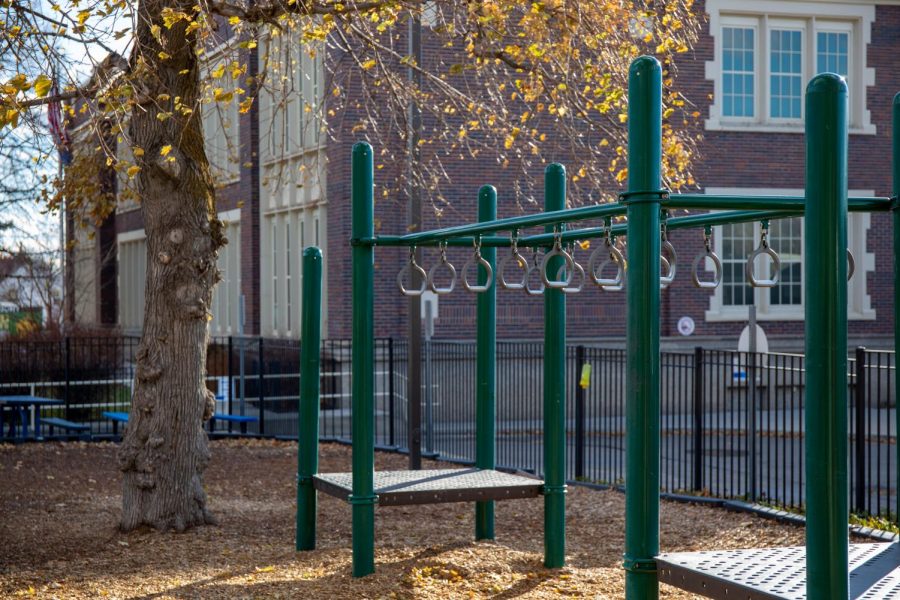Poma: The Pandemic Reveals Cracks in Our Education System
The McGillis School in Salt Lake City on Nov. 14th 2020. (Photo by Gwen Christopherson | The Daily Utah Chronicle)
November 18, 2020
In the age of the pandemic, schools have drastically changed and experienced difficulties in maintaining a safe but productive learning environment. In Utah especially, students of all ages have had classes move online. Even though we’ve done this for many months now, students continually encounter problems in this learning environment. University students sometimes have AWOL professors. Young children have had to teach themselves without supervision, especially when parents returned to work. For educators, technical difficulties and the risk of catching and spreading the virus in the classroom also contributes to a high-pressure atmosphere. This type of setting is not conducive to student success — it creates stress and exposes our education system’s shortcomings. We need to provide parents, teachers and students the resources needed to bring curriculums and course structure up to date in an ever-changing environment.
During the pandemic, Zoom and other technology-based classroom tools have provided opportunities that were unimaginable decades ago, but these platforms presented real challenges as well. Distractions, student engagement and participation are prevalent issues in online classes. And to add to the disruption, “zoom bombing” continues to expose students to uncomfortable, time-wasting and often very inappropriate situations.
“Zoom fatigue” also afflicts online learners at varying levels. We spend so much more time on screens these days, which has caused health concerns among parents and experts alike. With that, we often overlook the importance of socialization in the classroom, which many students are missing with online instruction. These factors cause many parents to worry about the long-term effects of online classes, the quality of education and so on.
Even with all these drawbacks, online learning remains the best option for many students and families. Some worry about coronavirus outbreaks in schools, and for good reason — Utah schools have become hotspots for the virus. Teachers then become responsible for their students’ health on top of managing behavior, delivering instructions, grading, planning curricula and keeping themselves safe. Many Utah teachers have felt disappointed by Governor Gary Herbert’s choice to wait on a statewide mask mandate and other safety measures until weeks after COVID-19 cases soared this fall. Some of these teachers believe online learning is the only way to keep everyone safe, at least until cases decrease significantly. It ultimately comes down to the safety of everyone in the community, and schools may have no choice but to stop in-person instruction either partially or completely until Utah’s numbers get under control.
However, we cannot ignore the harmful effects of learning online either. We’re seeing that now more than ever, there’s no separation between home and school. Students have homework after spending all day learning in their home with little stimulation. The psychological effects are draining for children and young adults alike. We’re constantly being reminded to manage our stress and spend less time on the internet, but that’s hard to do when everything in our lives is happening on our computers. Academic integrity has also been a cause for concern. On Zoom and Canvas, teachers have far less control over tests and assignments than they do normally. It’s difficult to tell who’s actually learning and who may need some help.
In addition, researchers are finding that the “homework gap” has become a learning gap with education in the COVID-19 era. Reliable internet access and a working computer are not guaranteed for people in Utah’s marginalized communities. In general, those in such communities have suffered the most from this switch to online or hybrid classrooms.
But online school feels necessary for these communities as well, since they are the most at risk for contracting the virus. As difficult as it is for some families to obtain reliable internet and technology access, it’s still better than the risk of catching the virus at school. Granite School District’s survey of their community’s approach to the 2020-2021 school year demonstrates this tension. Parents whose children attend lower-income high schools such as Granger and Kearns felt that it was better to stay at home.
COVID-19’s complicated educational pressures demonstrate the need to rethink our education system. We need smaller class sizes that are molded to what students want to learn. Not everyone learns at the same pace or in the same way, as has been made clear during COVID-19 and remote learning. Utah teachers like Lindsay Plummer have expressed the need for smaller class sizes, especially at a time like this. Other teachers stated that they want to know their students better, but with large class sizes and the changes to daily interactions that come with the hybrid environment, there must be tangible change to the system in order for that to happen.
We cannot continue to throw 35 small children in a classroom, or have over 300 university students in a class, and expect them to take in information like robots. Smaller class sizes are key to eliminating this disconnect that teachers have with students for the long term, which could in turn lower the risks of outbreaks in schools for the time being. We can’t place all the weight on teachers or parents or students alone. Solutions to our school systems must be collaborative and co-constructive if we want to see improvements during this time.
Given the numbers, it’s likely that virtual and hybrid classrooms will need to continue for quite a while — and won’t go away even after the pandemic is over. Instead of waiting around for a new normal, we need to recognize these flaws in education, both for virtual and in-person classrooms, and make proper and meaningful adjustments. Maybe then we will all be motivated to learn and rather than overwhelmed with our merging school and home environments.








